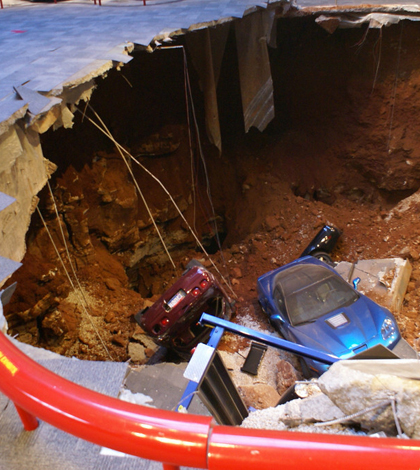Karst scientists monitor National Corvette Museum sinkhole that swallowed 8 classic cars

The National Corvette Museum sinkhole with the 2009 "Blue Devil" ZR1 Corvette visible (Credit: National Corvette Museum)
On Feb. 12, a giant sinkhole opened under the the National Corvette Museum in Bowling Green, Ky., cracking a gaping hole in the floor and swallowing eight cars on display.
The event has garnered sustained national news attention as crews continue to pull cars from the 40-by-36-foot-wide hole. All but one, a 2001 Mallett Hammer Z06, have been recovered.
“It’s down there buried somewhere,” said Jason Polk, an assistant professor of geosciences at Western Kentucky University. “It’s a huge, huge sinkhole.”
Polk heard about the ordeal just before he and some colleagues gathered for a meeting with the City of Bowling Green. They were there to discuss Under BG, a groundwater awareness campaign meant to educate people about the karst that underlies the region. They got the call right before the breakfast meeting was about to start
Polk, a caver as well as a scientist, recalled a short conversation.
“Do you want to eat breakfast or check out this sinkhole?” he said. “Well, let’s go check out the sinkhole.”
Since that day, he and graduate student Dan Nedvidek have worked with the museum, city and construction companies that are remediating the sinkhole to understand what happened and what could happen next.

The sinkhole under the museum’s skydome (Credit: National Corvette Museum)
Part of that includes monitoring a pond outside the building that fills a much older sinkhole. By keeping track of water in the pond, they can get an early idea of how water could be moving underground amongst the karst formations.
They installed a rain gauge at the site, as well as a pressure transducer to track water levels. That data will give them some indication of a water budget for the area, which will be useful for figuring out if the collapse was related to stormwater. Runoff from the museum’s roof and parking lot is supposed to be directed into the pond. The precipitation and water level data will help them make sure that’s happening.
“If that water’s supposed to be coming off into the pond, is it there?” Polk said. “If it isn’t showing up, then that means it’s probably going somewhere else.”

Western Kentucky University graduate student Dan Nedvidek deploying an EXO II sonde in a nearby pond (Credit: Jason Polk)
They also have a YSI EXO II multi-parameter sonde in the pond measuring temperature, conductivity, pH and turbidity every 10 minutes. In addition to helping track water in the system, the sonde will keep an eye on construction in the hole. That includes water pumped into the hole associated with the installation of support structures to stabilize the building. If the sonde in the pond picks up elevated turbidity, that could be a sign of a connection with the sinkhole.
The sinkhole has broken some Corvette-lover’s hearts, but it’s also providing researchers with an opportunity to learn more about the karst formations in the area.
“It’s been pretty wild and surreal, and it’s been a good collaboration,” Polk said. “The museum and construction company and city, everybody’s been very helpful and worked well together.”




0 comments